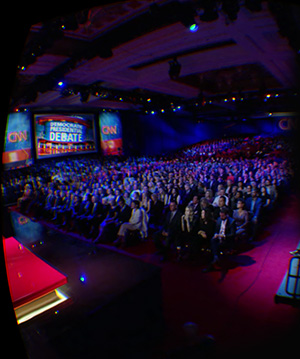Laguna Beach-based NextVR’s broadcast of the Democratic Presidential Debate live in VR was an historic first, but if you read the mainstream media accounts you’d think it was terrible. You might even think VR is back in the same place it has been for the decades — not ready for consumers. Which is unfortunate because that would be the wrong conclusion to make about the broadcast.
What we saw was the growing pain of a new medium piggybacking on an existing one for exposure. NextVR’s excellent streaming and camera technology was forced to be an afterthought to the needs of broadcast television. The placement of NextVR’s cameras was not ideal.
Instead of five candidates shown with clarity we saw blurry figures in the distance because the zoom lens of a broadcast camera and the view of a live in-person audience were higher priorities for NextVR’s broadcast partner CNN than the placement of VR cameras. Who could blame them? Millions of people were watching on TV while a tiny fraction tuned in with VR.
 The result was that the focus of the event was essentially blurry in VR. Yeah, you could look around at your surroundings just as in real life — cool, that’s the audience — but the distant VR camera placement next to broadcast TV cameras armed with zoom lenses meant you were more than encouraged to do so. Part of my mind wanted to look at the candidate speaking and another part said “no, there’s nothing interesting over there because it’s blurry.”
The result was that the focus of the event was essentially blurry in VR. Yeah, you could look around at your surroundings just as in real life — cool, that’s the audience — but the distant VR camera placement next to broadcast TV cameras armed with zoom lenses meant you were more than encouraged to do so. Part of my mind wanted to look at the candidate speaking and another part said “no, there’s nothing interesting over there because it’s blurry.”
If you’ve ever seen the cult classic They Live, the world in it is a place where people get a headache if they try to challenge the ever-present audio-visual mind control. I’m reminded of that movie when I read the uncomfortable feelings being described by some writers covering the debate’s VR broadcast. In NextVR’s debate stream people wanted to hear the arguments coming from the mouths of the candidates standing near them but were discouraged by the limitation of the camera placement. Uncomfortable feelings followed.
“The Democratic Debate In VR Was Novel—For About 3 Minutes,” read Fast Company’s headline while Time’s lede said “It turns out I have exactly the same tolerance for virtual reality as I do for presidential debates: After about 30 minutes, I get vaguely nauseous and have to step away.” A writer at Quartz couldn’t get the debate up and running at all, so she declared “Virtual reality is not ready for primetime.”
I’d argue primetime (TV) is not ready for virtual reality. It reminds me of the quote I ran when I wrote my first big feature on Oculus in late 2012:
“If there’s not something additive or functionally better, it’s not going to catch on,” said Jesse Divinich, vice president in charge of analysis at video-game research firm EEDAR. “It has to do a better job than the market standard that existed before.”
The sad part about the NextVR debate test is that everything about the technology, along with an Oculus headset, can deliver an additive experience to a televised debate but the experience was a net negative for many because of the physical placement of the cameras in the room. I don’t think it’s impossible with tech ready today from NextVR to show five candidates wrapped around directly in front of the VR viewer, each shown with the same scale and depth and with similar clarity as a television. That is a debate I’d want to watch in VR but it only happens if NextVR can place the camera in the right spot. That’s a chicken and egg problem because it won’t happen until enough viewers are ready to watch it in VR so that broadcasters see it as a higher priority than the legacy medium.
“Maybe sometime 10 or 15 years from now when there are a billion of these out in the world, then companies will be talking about having that be the primary thing that they are developing for,” Mark Zuckerberg recently said during a panel discussion. “But in the meantime I think the bigger market that we’re going for is that there are 250 million people who have Xboxes, PlayStations and Wiis.”
For me, games like Smash Hit on Gear VR and the forthcoming space-fighter EVE: Valkyrie on Rift do seem to cross that chasm into being better than the existing market standard of 2D gaming. It might seem a little crazy (and a little scary), but perhaps the vision shared by Hilmar Veigar, the CEO of the company making EVE: Valkyrie, should be the aim of all VR companies trying to pull people away from the real world for more than five minutes.
“Our company vision is to create virtual worlds more meaningful than real life,” Veigar said at the announcement of the consumer Rift earlier this year.




























